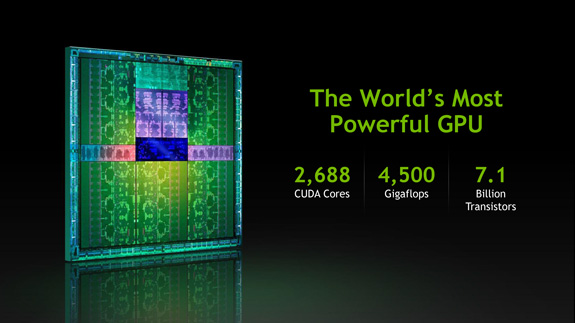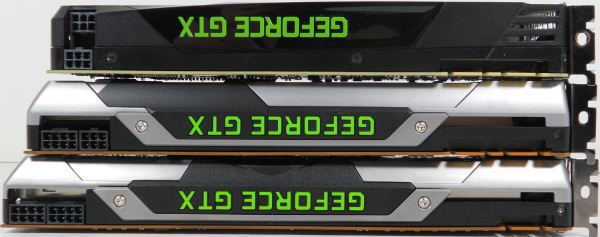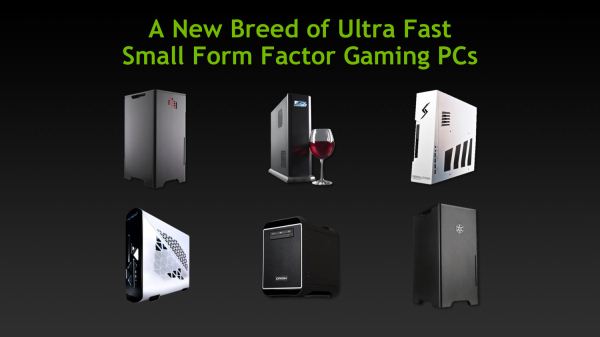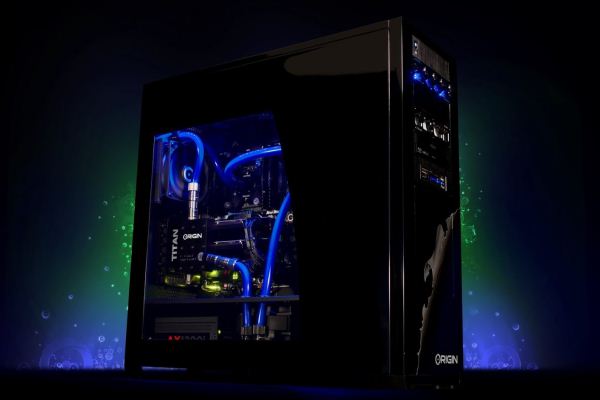NVIDIA's GeForce GTX Titan, Part 1: Titan For Gaming, Titan For Compute
by Ryan Smith on February 19, 2013 9:01 AM ESTWho’s Titan For, Anyhow?
Having established performance expectations, let’s talk about where Titan fits into NVIDIA’s product stack. First and foremost, though Titan is most certainly geared in part as a gaming video card (and that’s largely how we’ll be looking at it), that’s not the only role it serves. Titan is also going to be NVIDIA’s entry-level compute card. We’ll dive more into why that is in a bit in our feature breakdown, but the biggest factor is that for the first time on any consumer-level NVIDIA card, double precision (FP64) performance is uncapped. That means 1/3 FP32 performance, or roughly 1.3TFLOPS theoretical FP64 performance. NVIDIA has taken other liberties to keep from this being treated as a cheap Tesla K20, but for lighter workloads it should fit the bill.
As compared to the server and high-end workstation market that Tesla carves out, NVIDIA will be targeting the compute side of Titan towards researchers, engineers, developers, and others who need access to (relatively) cheap FP64 performance, and don’t need the scalability or reliability that Tesla brings. To that end Titan essentially stands alone in NVIDIA’s product stack; the next thing next to a FP64-constrained consumer card is the much more expensive Tesla K20.

Far more complex will be the gaming situation. Titan will not be pushing anything down in NVIDIA’s product stack, rather NVIDIA’s product stack will be growing up to accompany Titan. Like the GTX 690, NVIDIA is going to position Titan as a premium/luxury product, releasing it at the same $999 price point. GTX 690 itself will continue to exist at the same $999 price point, meanwhile GTX 680 will continue at its current price point of roughly $450.
Continuing the GTX 690 analogies, Titan will not only be sharing in GTX 690’s price point, but also in its design principles and distribution. This means Titan is a well-built card with its housing composed primarily of metals, with the same kind of luxury finish as the GTX 690. On the distribution side of things Asus and EVGA are once again NVIDIA’s exclusive partners for North America, and they will essentially be distributing reference Titan cards. In time we will see some specialized variation, with water-cooling in particular being an obvious route for EVGA to go. Factory overclocks are also on the table.
With the above in mind, it goes without saying that while GTX 690 had some historical precedence in its price, the same cannot be said for Titan. The price of NVIDIA’s top-tier single-GPU video cards hovered around $500 for the GeForce 400/500 series, and while they attempted to launch at $650 for the GTX 280, the launch of the Radeon HD 4870 quickly brought that price down to earth. As such this will be the most expensive single-GPU product out of NVIDIA yet.

Top To Bottom: GTX 680, GTX Titan, GTX 690
Ultimately NVIDIA is not even going to try to compete on a price-performance basis with Titan. There are a number of potential reasons for this – ranging from the competitive landscape to yields to needs for GK110 GPUs elsewhere within NVIDIA – and all of those reasons are probably true to some extent. Regardless, NVIDIA believes that like the GTX 690 they can sell Titan as a luxury product, and hence $999. The GTX 680 and below will compose NVIDIA’s more traditional price-performance competitive fare.
As to be expected from such a price, NVIDIA’s marketing department will be handling Titan in a similar fashion as they did GTX 690. This not only includes reiterating the fact that Titan is intended to be a luxury product, but also focusing on markets where luxury products are accepted, and where Titan in particular makes sense.
Perhaps not surprisingly, with $999 video cards the makeup of consumers shifts away from both traditional big-box OEMs and DIY builders, and towards boutique builders. Boutique builders are essentially already in the business of providing luxury computers, offering an outlet for luxury buyers who need not spend their time building their own computer, and want something of higher quality than what the typical OEM provides. As such while Titan will be sold on the open market just as like any other card, NVIDIA tells us that they expect a lot of those buyers are going to be the boutiques.
For Titan in particular, NVIDIA is going to be focusing on two boutique computer concepts, reflecting the blower design of Titan as opposed to the front/back exhausting design of the GTX 690. The first concept will be SFF PCs, where blowers are a necessity due to a lack of space (and often, a lack of heavy sound dampening), and where such cards can draw fresh air in from outside the chassis.
On the other end of the spectrum will be the ultra-enthusiast market where one Titan isn’t enough, and even two may come up short. Again thanks to the fact that it’s a blower, Titan can easily be fit in an ATX motherboard for tri-SLI operation, which NVIDIA envisions not just as the ultimate gaming computer, but the ultimate NV/3D Surround computer in particular. Multi-monitor gaming with graphically intensive games can quickly nullify the performance of even a single Titan card, so tri-SLI is NVIDIA’s solution to driving three monitors as well as one Titan can drive one monitor. At the same time however, NVIDIA intends to showcase that a tri-SLI system doesn’t need to be loud, despite the cramped conditions and despite the 750W+ that 3 Titans will pull, thanks to the high quality construction of the cards. Tri-SLI has been possible for a number of years, but NVIDIA believes with Titan in particular they have a solid grip on the heat and noise concerns it typically comes with.
To that end, as part of the Titan launch NVIDIA has shipped out a number of boutique systems in either a SFF or tri-SLI full tower configuration to reviewers, in order to show off their usage concepts in completed and well-constructed systems. Anand received a SFF Tiki from Falcon Northwest, while I have received a tri-SLI equipped Genesis from Origin PC. Like Titan itself we can’t talk about the performance of these systems, but we’ll be able to go into greater detail on Thursday when the complete NDA lifts. In the meantime we’ve been able to post a few impressions, which we’ve put up on their respective articles.
Moving on, with a $999 launch price NVIDIA’s competition will be rather limited. The GTX 690 is essentially a companion product; NVIDIA’s customers can either get the most powerful single-GPU card NVIDIA offers in a blower design, or an alternative design composed of two lesser GPUs in SLI, in a front and rear exhausting design. The GTX 690 will be the faster card, but at a higher TDP and with the general drawbacks of SLI. On the other hand Titan will be the more consistent card, the lower TDP card, the easier to cool card, but also the slower card. Meanwhile though it’s not a singular product, the GTX 680 SLI will also be another option, offering higher performance, higher TDP, more noise, and a cheaper price tag of around $900.
As for AMD, with their fastest single-GPU video card being the 7970 GHz Edition, offering performance closer to the GTX 680 than Titan, Titan essentially sits in a class of its own on the single-GPU front. AMD’s competition for Titan will be the 7970GE in CrossFire, and then the officially unofficial 7990 family, composed of the air-cooled PowerColor 7990, and the closed loop water-cooled Asus Ares II. But with NVIDIA keeping GTX 690 around, these are probably closer competitors to the multi-GPU 690 than they are the single-GPU Titan.
Finally, let’s talk launch availability. By scheduling the launch of Titan during the Chinese New Year, NVIDIA has essentially guaranteed this is a delayed availability product. Widespread availability is expected on the 25th, though cards may start popping up a couple of days earlier. NVIDIA hasn’t gone into depth for launch quantities, but they did specifically shoot down the 10,000 card rumor; this won’t be a limited run product and we don’t have any reason at this time to believe this will be much different from the GTX 690’s launch (tight at first, but available and increasingly plentiful).
| February 2013 GPU Pricing Comparison | |||||
| AMD | Price | NVIDIA | |||
| $1000 | GeForce GTX Titan/690 | ||||
| (Unofficial) Radeon HD 7990 | $900 | ||||
| Radeon HD 7970 GHz Edition | $450 | GeForce GTX 680 | |||
| Radeon HD 7970 | $390 | ||||
| $350 | GeForce GTX 670 | ||||
| Radeon HD 7950 | $300 | ||||












157 Comments
View All Comments
hammer256 - Tuesday, February 19, 2013 - link
Ryan's analysis of the target market for this card is spot on: this card is for small scale HPC type workloads, where the researcher just want to build a desktop-like machine with a few of those cards. I know that's what I use for my research. To me, this is the real replacement of the GTX 580 for our purposes. The price hike is not great, but when put to context of the K20X, it's a bargain. I'm lusting to get 8 of these cards and get a Tyan GPU server.Gadgety - Tuesday, February 19, 2013 - link
While gamers see little benefit, it looks like this is the card for GPU rendering, provided the software developers at VRay, Octane and others find a way to tap into this. So one of these can replace the 3xGTX580 3GBs.chizow - Tuesday, February 19, 2013 - link
Nvidia has completely lost their minds. Throwing in a minor bone with the non-neutered DP performance does not give them license to charge $1K for this part, especially when DP on previous flagship parts carried similar performance relative to Tesla.First the $500 for a mid-range ASIC in GTX 680, then $1200 GTX 690 and now a $1000 GeForce Titan. Unbelievable. Best of luck Nvidia, good luck competing with the next-gen consoles at these price points, or even with yourselves next generation.
While AMD is still at fault in all of this for their ridiculous launch pricing for the 7970, these recent price missteps from Nvidia make that seem like a distant memory.
ronin22 - Wednesday, February 20, 2013 - link
Bullshit of a typical NV hater.The compute-side of the card isn't a minor bone, it's its prime feature, along with the single-chip GTX690-like performance.
"especially when DP on previous flagship parts carried similar performance relative to Tesla"
Bullshit again.
Give me a single card that is anywhere near the K20 in DP performance and we'll talk.
You don't understand the philosophy of this card, as many around here.
Thanksfully, the real intended audience is already recognizing the awesomeness of this card (read previous comments).
You can go back to playing BF3 on your 79xx, but please close the door behind you on your way out ;)
chizow - Wednesday, February 20, 2013 - link
Heh, your ignorant comments couldn't be further from the truth about being an "NV hater". I haven't bought an ATI/AMD card since the 9700pro (my gf made the mistake of buying a 5850 though, despite my input) and previously, I solely purchased *multiple* Nvidia cards in this flagship market for the last 3 generations.I have a vested interest in Nvidia in this respect as I enjoy their products, so I've never rooted for them to fail, until now. It's obvious to me now that between AMD's lackluster offerings and ridiculous launch prices along with Nvidia's greed with their last two high-end product launches (690 and Titan), that they've completely lost touch with their core customer base.
Also, before you comment ignorantly again, please look up the DP performance of GTX 280 and GTX 480/580 relative to their Tesla counterparts. You will see they are still respectable, ~1/8th of SP performance, which was still excellent compared to the completely neutered 1/32 DP of GK104 Kepler. That's why there is still a high demand for flagship Fermi parts and even GT200 despite their overall reputation as a less desirable part due to their thermal characteristics.
Lastly, I won't be playing BF3 on a 7970, try a pair of GTX 670s in SLI. There's a difference between supporting a company through sound purchasing decisions and stupidly pissing away $1K for something that cost $500-$650 in the past.
The philosophy of this card is simple: Rob stupid people of their money. I've seen enough of this in the past from the same target audience and generally that feeling of "awesomeness" is quickly replaced by buyer's remorse as they realize that slightly higher FPS number in the upper left of their screen isn't worth the massive number on their credit card statement.
CeriseCogburn - Sunday, February 24, 2013 - link
That one's been pissing acid since the 680 launch, failed and fails to recognize the superior leap of the GTX580 over the prior gen, which gave him his mental handicap believing he can get something for nothing, along with sucking down the master amd fanboy Charlie D's rumor about the "$350" flagship nVidia card blah blah blah 680 blah blah second tier blah blah blah.So instead the rager now claims he wasted near a grand on two 670's - R O F L - the lunatics never end here man.
bamboo69 - Tuesday, February 19, 2013 - link
Origin is using EK Waterblocks? i hope they arentt nickel plated, their nickel blocks flakeKnock24 - Wednesday, February 20, 2013 - link
I've seen it mentioned in the article that Titan has HyperQ support, but I've also read the opposite elsewhere.Can anyone confirm that HyperQ is supported? I'm guessing the simpleHyperQ Cuda SDK example might reveal if it's supported or not.
torchedguitar - Wednesday, February 20, 2013 - link
HyperQ actually means two separate things... One part is the ability to have a process act as a server, providing access to the GPU for other MPI processes. This is supported on Linux using Tesla cards (e.g. K20X) only, so it won't work on GTX Titan (it does work on Titan the supercomputer, though). The other part of HyperQ is that there are multiple hardware queues available for managing the work on multiple CUDA streams. GTX Titan DOES support this part, although I'm not sure just how many of these will be enabled (it's a tradeoff, having more hardware streams allows more flexibility in launching concurrent kernels, but also takes more memory and takes more time to initialize). The simpleHyperQ sample is a variation of the concurrentKernels sample (just look at the code), and it shows how having more hardware channels cuts down on false dependencies between kernels in different streams. You put things in different stream because they have no dependencies on each other, so in theory nothing in stream X should ever get stuck waiting for something in stream Y. When that does happen due to hitting limits of the hardware, it's a false dependency. An example would be when you try to time a kernel launch by wrapping it with CUDA event records (this is the simpleHyperQ sample). GPUs before GK110 only have one hardware stream, and if you take a program that launches kernels concurrently in separate streams, and wrap all the kernels with CUDA event records, you'll see that suddenly the kernels run one-at-a-time instead of all together. This is because in order to do the timing for the event, the single hardware channel queues up the other launches while waiting for each kernel to finish, then it records the end time in the event, then goes on to the next kernel. With HyperQ's addition of more hardware streams, you get around this problem. Run the simpleHyperQ sample on a 580 or a 680 through a tool like Nsight and look at the timeline... You'll see all the work in the streams show up like stair steps -- even though they're in different streams, they happen one at a time. Now run it on a GTX Titan or a K20 and you'll see many of the kernels are able to completely overlap. If 8 hardware streams are enabled, the app will finish 8x faster, or if 32 are enabled, 32x faster.Now, this sample is extremely contrived, just to illustrate the feature. In reality, overlapping kernels won't buy you much speedup if you're already launching big enough kernels to use the GPU effectively. In that case, there shouldn't much room left for overlapping kernels, except when you have unbalanced workloads where many threads in a kernel finish quickly but a few stragglers run way longer. With HyperQ, you greatly increase your chances that kernels in other streams can immediately start using the resources freed up when some of the threads in a kernel finish early, instead of waiting for all threads in the kernel to finish before starting the next kernel.
vacaloca - Monday, March 4, 2013 - link
I wanted to say that you hit the nail on the head... I just tested the simpleHyperQ example, and indeed, the Titan has 8 hardware streams enabled. For every multiple higher than 8, and the "Measured time for sample" goes up.